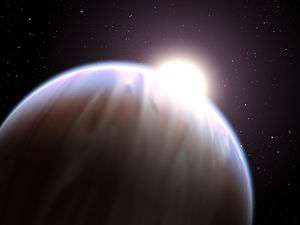NGTS-1b
NGTS-1b is a confirmed hot Jupiter-sized extrasolar planet orbiting NGTS-1, a red dwarf star about half the mass and radius of the Sun, every 2.65 days.[4] The NGTS-1 system is about 600 light-years from Earth in the Columba constellation.[1][2][5]
Discovery
The exoplanet, NGTS-1b, was discovered by the Next-Generation Transit Survey.[2] Daniel Bayliss, of the University of Warwick, and lead author of the study describing the discovery of NGTS-1b, stated, "The discovery of NGTS-1b was a complete surprise to us—such massive planets were not thought to exist around such small stars – importantly, our challenge now is to find out how common these types of planets are in the Galaxy, and with the new Next-Generation Transit Survey facility we are well-placed to do just that."[5]
Characteristics
Mass, radius and temperature
NGTS-1b is a hot Jupiter-sized gas giant exoplanet that has a mass of 0.812 MJ and a radius of 1.33 RJ, where MJ and RJ are the mass and radius of Jupiter.[1][2]
Host star
The planet orbits an M0.5 dwarf star about half the mass (0.617 M☉) and radius (0.573 R☉) of the Sun.[2][3]
Orbit
NGTS-1b orbits about 4.5 million km (2.8 million mi) from the host star every 2.6473 Earth-days.[1][2][3][6]
See also
References
- 1 2 3 4 5 6 7 8 Bayliss, Danile; et al. (31 October 2017). "NGTS-1b: A hot Jupiter transiting an M-dwarf". Monthly Notices of the Royal Astronomical Society. 475 (4): 4467. arXiv:1710.11099. Bibcode:2018MNRAS.475.4467B. doi:10.1093/mnras/stx2778.
- 1 2 3 4 5 6 7 Lewin, Sarah (31 October 2017). "Monster Planet, Tiny Star: Record-Breaking Duo Puzzles Astronomers". Space.com. Retrieved 1 November 2017.
- 1 2 3 4 5 6 7 8 9 10 11 12 13 14 Staff (2017). "Planet NGTS-1 b". Extrasolar Planets Encyclopaedia. Retrieved 1 November 2017.
- ↑ Griffini, Andrew (2 November 2017). "Huge 'monster' planet could challenge scientists' theory of how worlds form". Times of India. Retrieved 2 November 2017.
- 1 2 Staff (31 October 2017). "'Monster' planet discovery challenges formation theory". Phys.org. Retrieved 1 November 2017.
- ↑ Dvorsky, George (31 October 2017). "This Tiny Star Hosts a Planet Nearly the Size of Jupiter". Gizmodo. Retrieved 1 November 2017.
External links
- The Next Generation Transit Survey Becomes Operational at Paranal, ESO archive, The Messenger 165 – September 2016


